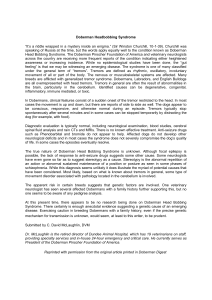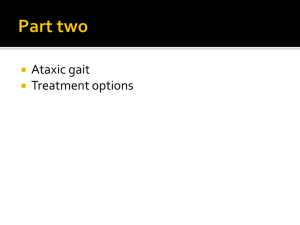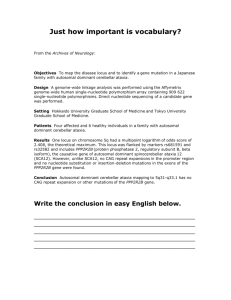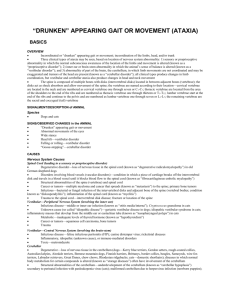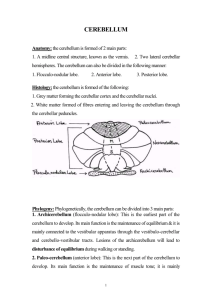SNAP Cats snapcats.org Ataxia, Vestibular Disease in Cats There
advertisement
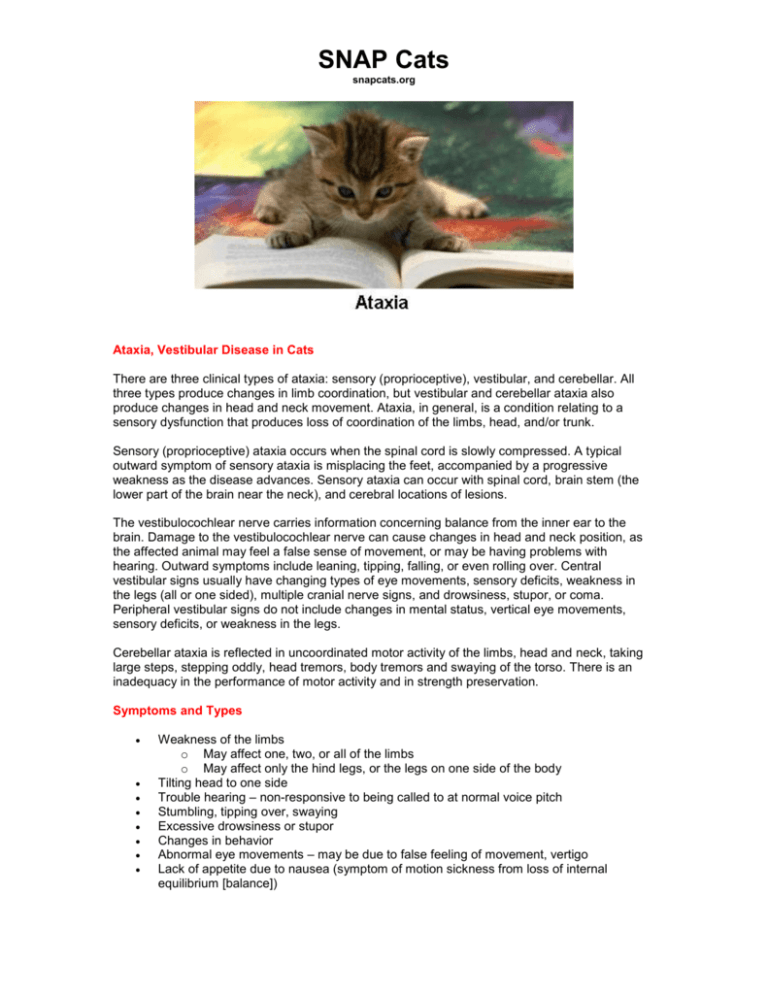
SNAP Cats snapcats.org Ataxia, Vestibular Disease in Cats There are three clinical types of ataxia: sensory (proprioceptive), vestibular, and cerebellar. All three types produce changes in limb coordination, but vestibular and cerebellar ataxia also produce changes in head and neck movement. Ataxia, in general, is a condition relating to a sensory dysfunction that produces loss of coordination of the limbs, head, and/or trunk. Sensory (proprioceptive) ataxia occurs when the spinal cord is slowly compressed. A typical outward symptom of sensory ataxia is misplacing the feet, accompanied by a progressive weakness as the disease advances. Sensory ataxia can occur with spinal cord, brain stem (the lower part of the brain near the neck), and cerebral locations of lesions. The vestibulocochlear nerve carries information concerning balance from the inner ear to the brain. Damage to the vestibulocochlear nerve can cause changes in head and neck position, as the affected animal may feel a false sense of movement, or may be having problems with hearing. Outward symptoms include leaning, tipping, falling, or even rolling over. Central vestibular signs usually have changing types of eye movements, sensory deficits, weakness in the legs (all or one sided), multiple cranial nerve signs, and drowsiness, stupor, or coma. Peripheral vestibular signs do not include changes in mental status, vertical eye movements, sensory deficits, or weakness in the legs. Cerebellar ataxia is reflected in uncoordinated motor activity of the limbs, head and neck, taking large steps, stepping oddly, head tremors, body tremors and swaying of the torso. There is an inadequacy in the performance of motor activity and in strength preservation. Symptoms and Types Weakness of the limbs o May affect one, two, or all of the limbs o May affect only the hind legs, or the legs on one side of the body Tilting head to one side Trouble hearing – non-responsive to being called to at normal voice pitch Stumbling, tipping over, swaying Excessive drowsiness or stupor Changes in behavior Abnormal eye movements – may be due to false feeling of movement, vertigo Lack of appetite due to nausea (symptom of motion sickness from loss of internal equilibrium [balance]) SNAP Cats snapcats.org Causes Neurologic o Cerebellar o Degenerative: Abiotrophy (prematurely the cerebellum loses function) o Anomalous: Underdevelopment secondary to perinatal infection with panleukopenia virus in cats A cyst located near fourth ventricle o Cancer o Infectious – feline infectious peritonitis (FIP) o Inflammatory, unknown causes, immune-mediated o Toxic Vestibular – central nervous system (CNS) o Infectious: Feline infectious peritonitis (FIP), rickettsial diseases o Inflammatory, unknown causes, immune-mediated o Toxic Vestibular—Peripheral nervous system o Infectious: Middle ear Fungal o Diseases of unknown cause o Metabolic o Cancer o Traumatic Spinal Cord o Degeneration of the nerve roots and spinal cords o Vascular: Loss of blood to nervous system due to blockage of blood vessels by a blood clot o Anomalous: Spinal cord and vertebral malformation Spinal cyst o Cancer o Infectious o Traumatic Metabolic o Anemia o Electrolyte disturbances – low potassium and low blood sugar Diagnosis You will need to give your veterinarian a thorough history of your cat's health, onset of symptoms, and possible incidents that might have preceded this condition. Your veterinarian will order standard tests, including a blood chemical profile, a complete blood count, a urinalysis and an electrolyte panel. Imaging is crucial for determining whether the disease is localized to the peripheral vestibular system, the spinal cord, or the cerebellum. Computed tomography (CT), magnetic resonance imaging (MRI), myelography and spinal X-rays can all be useful diagnostic tools for non-invasive internal examinations. Chest and abdominal X-rays are also important for determining if cancer or systemic fungal infection is present. An abdominal ultrasound should be done to check liver, kidney, adrenal or pancreatic functions. SNAP Cats snapcats.org If the source of the disease is suspected to be in the nervous system, a sample of cerebrospinal fluid (CSF) will be taken for laboratory analysis.



